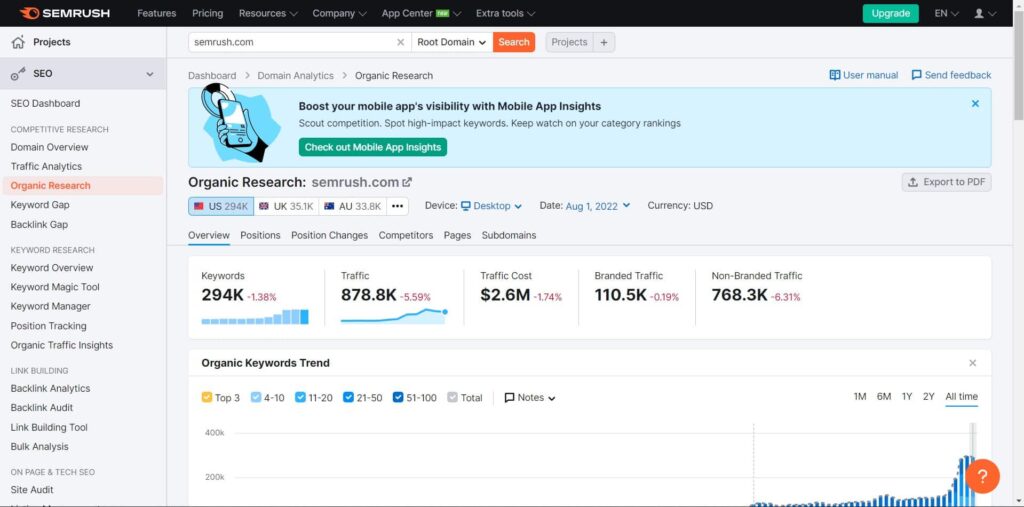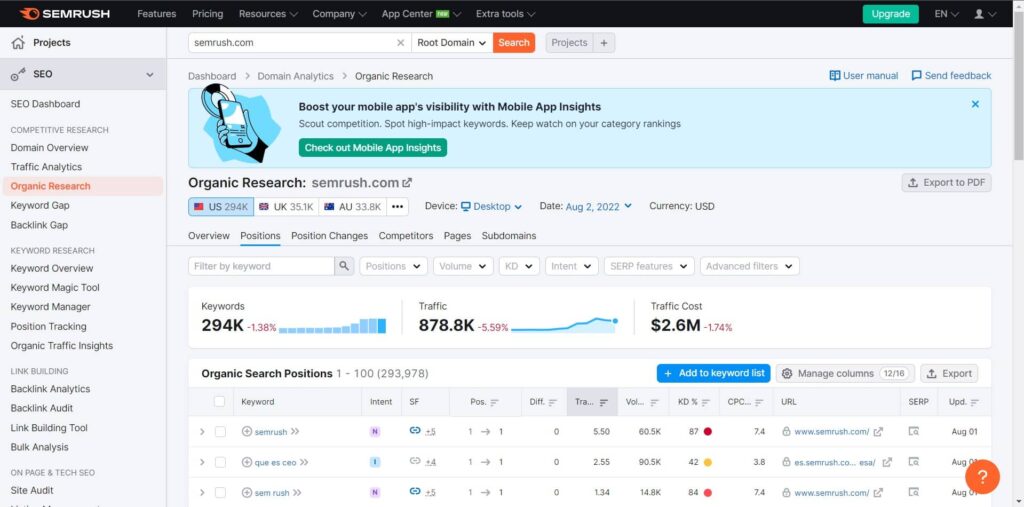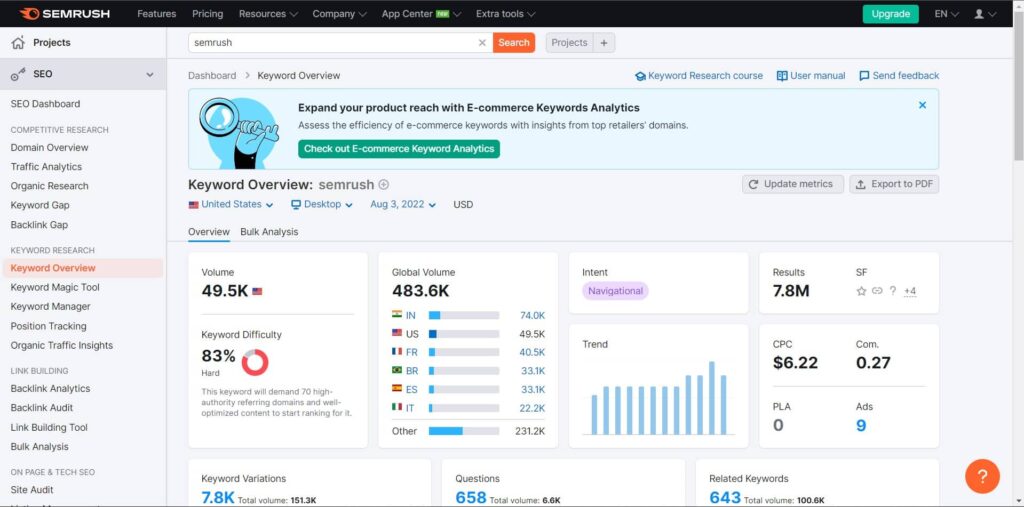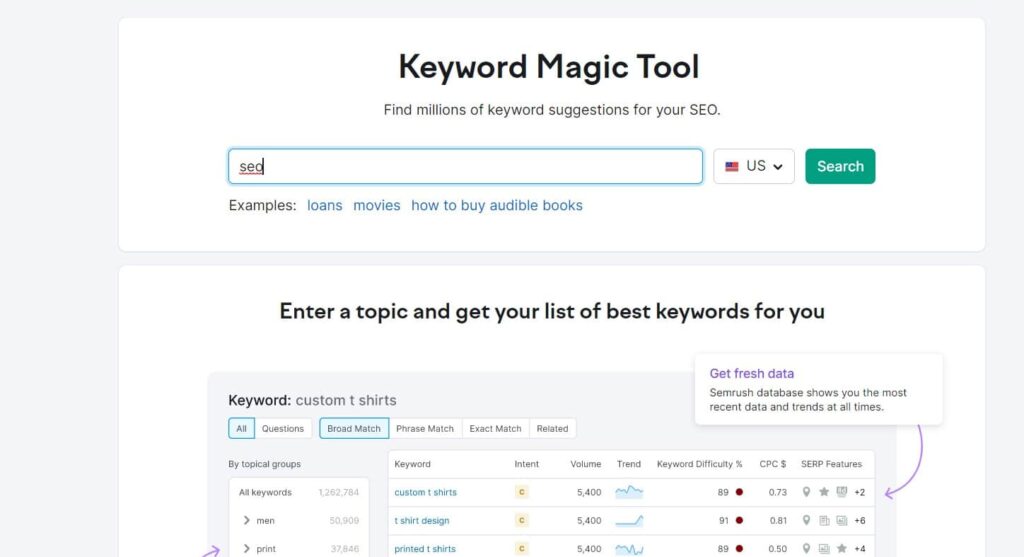Are you looking for a quick guide for keyword research semrush? then you are in the right place.
In this post, we are going to give you a brief part of the information about keyword research semrush. Before going to the keyword research guide we are giving you a small intro about what is keyword research.
Let get started
What is keyword Research?
The terms individuals use in search engines to find information are known as keywords. Finding out where the search traffic in your industry comes from and identifying the keywords your website may use for marketing are the goals of keyword research.
- Using keyword research can assist you:
- Recognize and connect with your audience
- Discover new, pertinent subjects to address on your website and obtain quality leads
- Greater sales
- Boost advertising campaigns to increase clicks and impressions
- Spread the word about your brand
Basics of Keyword Research
The Semrush toolbox gives you a number of options for finding the best keywords; however, you should always start with the tried-and-true methods of traditional keyword research.
Steps to Follow
- Receive a Fast Analysis
- Create a master keyword list.
- Get a Competitive Advantage
Keyword Research Semrush With Organic Research

Keyword research with semrush the use of organic research, you can locate your rivals in organic search, check the terms they rank for, and look at the recent fluctuations in their page rankings.
Start by visiting Organic Research, typing your domain name into the search box, choosing the Competitors option, and scrolling down to the table:
You currently own a list of your rivals; they will act as your seed domains. The list is sorted by “Competition Level,” which measures how closely a website is a competitor to the one you entered. This metric is based on “Competition Level,” which measures the total number of keywords a competitor is ranked for and the proportion of those keywords that the competitor shares with the given website.
Sort the domain list according to the degree of competition or the number of common keywords. To reassemble the report for the website, click the domain name or the arrow icon to open it in a new tab, respectively.
How to Get the Keywords of Your Competitors
The Positions report of the Organic Research for your seed domain is the next destination.

Here, you can view all of the search terms for which a specific domain is included within the top 100 results. The URL of the associated landing page and other metrics are provided with each term a domain ranks for in order to help you with your study.
By selecting the Advanced Filters button, you can add more filtering options to the likely too-long list you will receive.
For instance, we can locate keywords that contain the phrase “cat food” and have a KD lower than 60.
Experiment with various combinations of additional filtering choices to obtain the most pertinent data.
Keyword Research With Keyword Overview Feature
The quickest approach to receive a quick examination of your keywords is via a Keyword Overview. a thorough breakdown of all essential keyword parameters, including volume, CPC, paid search competition, top-ranking pages, ad content, and more.

Open the report, type your search term into the field, and begin analyzing.
Create a keyword master list with the Keyword Magic Tool.
A strong tool for thorough keyword research with Semrush and creating excellent master lists is Keyword Magic. Find semantically similar long-tail keywords that are divided into topic-specific subgroups as you research your specialty.
Initially, use just one seed keyword:

Start working and click Search:
To obtain specialty long-tails and inspiration for your PPC ad groups, look through the proposed groups and subgroups of relevant themes. Sort groups based on size or the number of keywords; use the eye symbol to omit groups you don’t require. Remember that the list of topics will be affected by the advanced filters you have applied.
Pay attention to the Match Modifiers, which let you expand or decrease the keyword choices as desired.
Use the Questions Filter to organize keywords that are based on questions. These search terms generate a tonne of high-quality traffic and frequently result in featured snippets, which can act as a quick route to the top of SERPs.
The range of word counts, search volume, keyword difficulty, CPC, competitive density, and the number of results in the SERP can all be used as versatile Advanced filters to further define the scope of your keyphrases. Select SERP characteristics to display the terms that activate them, and include or omit keywords with broad or exact matches (some words can trigger multiple features).
Here is a short video tutorial that will show you how to utilise this tool along with topic research to create a content strategy that is in line with search.
View every domain that placed a bid on the specified keyword and ran a PPC ad in the previous 12 months.
The cross-sectional number represents the paid position that the advertisement held during the specified month. It should be noted that this placement doesn’t always correspond to the ad’s position on the search results page. Even if you place the highest offer, your advertisement may still show up behind the natural search results.
Additionally, you may view the total number of advertising, ad traffic pricing, and ad traffic volume for that keyword.
How to Find Ideas for Content (Using Semrush’s Topic Research Tool)
Find a fresh subject for your upcoming blog post, podcast episode, or eBook. Semrush’s Topic Research tool is where you’ll probably find the solution.
Your content development process might become more precise with the help of the topic research tool. For your subsequent piece of content, it generates a lengthy list of original themes.

And using it is quite simple.
This is how it goes:
Go to Content Marketing > Topic Research on your Semrush dashboard.
In the search box, type your topic or one or more keywords:
Semrush will respond with a list of potential subtopics for the topic you searched on in a few seconds.
Report on Topical Study – Cards View
The top 3 headlines for the primary keywords will be shown for each subtopic.
If you’re using this tool for the first time, you might find the way the data is presented to be a little confusing. So, be mindful.
Four distinct displays of the data are available: cards, explorer, overview, and mindmap. Cards are the default view.
You can choose from any of the four ways to view the list of subtopics in the format of your choice.
Three groups comprise the subtopics:
- Headlines
- Questions
- Related Searches
Keyword Research With Keyword Gaps, Compare Keyword Portfolios
Want to know how your rivals are doing? Which search terms are your competitors ranking for that you are missing? Utilize Semrush’s “Keyword Gap” function.

Where Can I Find the Choice?
The “Keyword Gap” option can be found in the main menu, below the area for competitive research.
Option for Analyzing Keywords Used by Competitors: Keyword Gap
How should I use the Keyword Gap function?
Select Keyword Gap from the main menu by clicking it.
Enter the URL of your website in the first field that says “you.”
You can put the URLs of your competitors’ websites in the fields that follow.
A list of all the keywords that your rivals are ranking for will appear when you click the comparison button.
Examine the specifics and look deeper to find opportunities for your website.
Additionally, you can view the information below:
The keywords that both you and your rival share.
Missing search terms: those that your rival is ranking for but you are not.
Weak: Keywords where you are ranked lower than your rival.
Strong: The search terms for which you outperform your rival.
Untapped: These are the ones that you are not ranking for but one of your rivals is.
Some Important Keyword Terms You Need To know
Below we are given some important terms you need to know for keyword research semrush or any other tool
Ad keyword: The query that prompts sponsored results is known as an ad keyword.
Click Potential: A metric called “Click Potential” is used to estimate the likelihood that someone will click on your website if your search result appears at the top of the SERP. The SERP features that prevent users from clicking on organic website results determine the click potential of a result.
Common Keywords: Common keywords are those for which several domains appear on the first page of Google results.
CTR: CTR (Click-Through-Rate) is the proportion of search results viewers that clicked on an advertisement or a link.
Features Snippet: The most visible SERP component that shows the above search results and offers the most pertinent response to a query is a featured snippet.
Keyword: A word or phrase used in an internet search is often known as a keyword or search term.
Keyword Difficulty: An evaluation of how difficult it would be to rank highly for a keyword in organic search results or how expensive it would be to appear in advertising. To pick intelligently, you must consider the degree of difficulty.
Local Pack: A SERP feature that displays queries with a local focus or that contain a place name (such as “best pizza in Philadelphia” or “pizza near me”).
Long Tail Keywords: The search query that is in the “long tail” of the search demand curve is referred to as a “long tail term.” These are keywords with modest monthly search traffic, but they frequently have more focused searcher intent and a better likelihood of conversion via SEO or PPC. By using the Keyword Magic Tool and adding filters for word count, keyword difficulty, volume, and other factors, you may find long tail keywords in Semrush.
Negative Keywords: Negative keywords are those that let you pick what you don’t want a Google Ads campaign to target. Negative keywords can be established with match types including exact match, phrase match, and broad match just as regular keywords in an advertising campaign. When you include a negative term in your campaign, your advertisements won’t show up in the related search results. By using this technique, advertisers can reduce costs and increase ROI.
PPC: PPC (Pay per Click) is an internet advertising strategy that uses sponsored advertisements to drive visitors to a website (Google Ads). A PPC campaign’s effectiveness depends on selecting the appropriate keywords. Three payment options exist:
- CPC: Advertisers only pay CPC (Cost per Click) when the ad is clicked.
- CPM: Advertisers pay based on how many times their ads are displayed, or CPM (Cost per Impression).
- CPA: Advertisers are charged a CPA (cost per acquisition) fee after users accomplish the specified goal.
Search Intent: Every search query is motivated by a specific aim, thus effective keyword research should address both the what and the why of people’s searches. Of course, a keyword’s intent isn’t always obvious, but most of the time, it fits into one of four categories:
Informational — Looks for precise information, whether it be a clear response to an a query or in-depth discussion of a subject.
for instance, “how to create a Gmail account “
Navigational — These searches use the name of a company, item, or service to find a specific webpage or website.
(Example: “Instagram”)
Commercial – People who are thinking about making a purchase and want to research their options do this sort of search.
(Such as, “Buys Dog Toys”)
The technique of increasing a website’s traffic and revenue through natural search engine rankings is known as SEO (Search Engine Optimization).
SERP: The list of websites returned by a search engine in response to a query is known as a SERP (Search Engine Results Page).
SERP Feature: An additional layer of information or context on top of a standard search engine result is known as a SERP feature. There are many different SERP elements that are activated by different sorts of keywords.
Search Volume: Volume is a core keyword metric that displays the number of searches made for a specific keyword over a specified period of time (usually per month). Keep in mind that seasonality (such as “black Friday discounts”) might have an impact on a keyword’s popularity.
Web Traffic: Web traffic is simply the flow of people visiting your website. The success of a website or page is determined by the type and volume of traffic. Although there are many ways for visitors to access the pages of your website, we’ll concentrate on the two major traffic sources that demand keyword research:
Organic Traffic: Visitors who arrived at a website via an organic search result on a search engine; this type of traffic is essential for a website’s long-term performance.
Paid Traffic: Visitors from paid sources are referred to as “paid traffic” (advertising).
Conclusion Semrush Keyword Research
You must master keyword research if you want your website to rank higher in search results. Fortunately, using a tool like Semrush to conduct keyword research and choose the ideal keywords for your website is simple and enjoyable.
This overview of Semrush’s keyword research tools should have given you a good foundation to begin your keyword research.
Keep in mind that keyword research is a continuous process. To make sure they are optimised for pertinent keywords, you must frequently revisit and edit your older content. By doing this, you’ll be able to keep up your SEO ranks and keep a step ahead of your key organic rivals.



